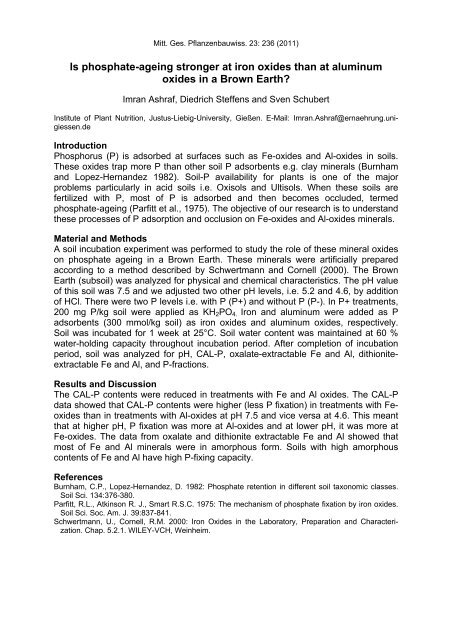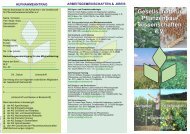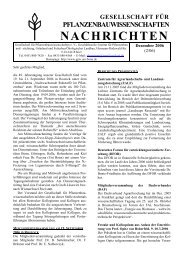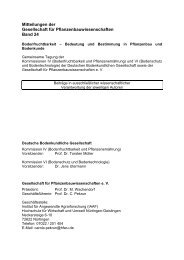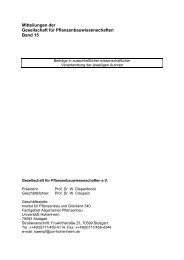Mitteilungen der Gesellschaft für Pflanzenbauwissenschaften Band 23
Mitteilungen der Gesellschaft für Pflanzenbauwissenschaften Band 23
Mitteilungen der Gesellschaft für Pflanzenbauwissenschaften Band 23
Sie wollen auch ein ePaper? Erhöhen Sie die Reichweite Ihrer Titel.
YUMPU macht aus Druck-PDFs automatisch weboptimierte ePaper, die Google liebt.
Mitt. Ges. Pflanzenbauwiss. <strong>23</strong>: <strong>23</strong>6 (2011)<br />
Is phosphate-ageing stronger at iron oxides than at aluminum<br />
oxides in a Brown Earth?<br />
Imran Ashraf, Diedrich Steffens and Sven Schubert<br />
Institute of Plant Nutrition, Justus-Liebig-University, Gießen. E-Mail: Imran.Ashraf@ernaehrung.unigiessen.de<br />
Introduction<br />
Phosphorus (P) is adsorbed at surfaces such as Fe-oxides and Al-oxides in soils.<br />
These oxides trap more P than other soil P adsorbents e.g. clay minerals (Burnham<br />
and Lopez-Hernandez 1982). Soil-P availability for plants is one of the major<br />
problems particularly in acid soils i.e. Oxisols and Ultisols. When these soils are<br />
fertilized with P, most of P is adsorbed and then becomes occluded, termed<br />
phosphate-ageing (Parfitt et al., 1975). The objective of our research is to un<strong>der</strong>stand<br />
these processes of P adsorption and occlusion on Fe-oxides and Al-oxides minerals.<br />
Material and Methods<br />
A soil incubation experiment was performed to study the role of these mineral oxides<br />
on phosphate ageing in a Brown Earth. These minerals were artificially prepared<br />
according to a method described by Schwertmann and Cornell (2000). The Brown<br />
Earth (subsoil) was analyzed for physical and chemical characteristics. The pH value<br />
of this soil was 7.5 and we adjusted two other pH levels, i.e. 5.2 and 4.6, by addition<br />
of HCl. There were two P levels i.e. with P (P+) and without P (P-). In P+ treatments,<br />
200 mg P/kg soil were applied as KH2PO4. Iron and aluminum were added as P<br />
adsorbents (300 mmol/kg soil) as iron oxides and aluminum oxides, respectively.<br />
Soil was incubated for 1 week at 25°C. Soil water content was maintained at 60 %<br />
water-holding capacity throughout incubation period. After completion of incubation<br />
period, soil was analyzed for pH, CAL-P, oxalate-extractable Fe and Al, dithioniteextractable<br />
Fe and Al, and P-fractions.<br />
Results and Discussion<br />
The CAL-P contents were reduced in treatments with Fe and Al oxides. The CAL-P<br />
data showed that CAL-P contents were higher (less P fixation) in treatments with Feoxides<br />
than in treatments with Al-oxides at pH 7.5 and vice versa at 4.6. This meant<br />
that at higher pH, P fixation was more at Al-oxides and at lower pH, it was more at<br />
Fe-oxides. The data from oxalate and dithionite extractable Fe and Al showed that<br />
most of Fe and Al minerals were in amorphous form. Soils with high amorphous<br />
contents of Fe and Al have high P-fixing capacity.<br />
References<br />
Burnham, C.P., Lopez-Hernandez, D. 1982: Phosphate retention in different soil taxonomic classes.<br />
Soil Sci. 134:376-380.<br />
Parfitt, R.L., Atkinson R. J., Smart R.S.C. 1975: The mechanism of phosphate fixation by iron oxides.<br />
Soil Sci. Soc. Am. J. 39:837-841.<br />
Schwertmann, U., Cornell, R.M. 2000: Iron Oxides in the Laboratory, Preparation and Characterization.<br />
Chap. 5.2.1. WILEY-VCH, Weinheim.


